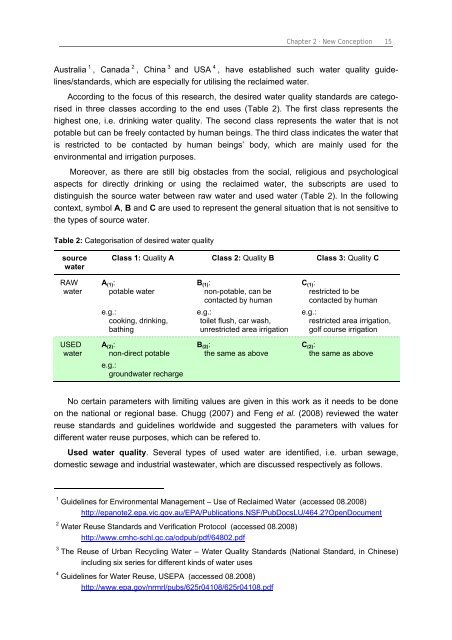Chapter 3 Decision Support Model (IUWS-DSM) - Tubdok
Chapter 3 Decision Support Model (IUWS-DSM) - Tubdok
Chapter 3 Decision Support Model (IUWS-DSM) - Tubdok
Create successful ePaper yourself
Turn your PDF publications into a flip-book with our unique Google optimized e-Paper software.
<strong>Chapter</strong> 2 · New Conception 15<br />
Australia 1 , Canada 2 , China 3 and USA 4 , have established such water quality guidelines/standards,<br />
which are especially for utilising the reclaimed water.<br />
According to the focus of this research, the desired water quality standards are categorised<br />
in three classes according to the end uses (Table 2). The first class represents the<br />
highest one, i.e. drinking water quality. The second class represents the water that is not<br />
potable but can be freely contacted by human beings. The third class indicates the water that<br />
is restricted to be contacted by human beings’ body, which are mainly used for the<br />
environmental and irrigation purposes.<br />
Moreover, as there are still big obstacles from the social, religious and psychological<br />
aspects for directly drinking or using the reclaimed water, the subscripts are used to<br />
distinguish the source water between raw water and used water (Table 2). In the following<br />
context, symbol A, B and C are used to represent the general situation that is not sensitive to<br />
the types of source water.<br />
Table 2: Categorisation of desired water quality<br />
source<br />
water<br />
RAW<br />
water<br />
USED<br />
water<br />
Class 1: Quality A Class 2: Quality B Class 3: Quality C<br />
A(1):<br />
potable water<br />
e.g.:<br />
cooking, drinking,<br />
bathing<br />
A(2):<br />
non-direct potable<br />
e.g.:<br />
groundwater recharge<br />
B(1):<br />
non-potable, can be<br />
contacted by human<br />
e.g.:<br />
toilet flush, car wash,<br />
unrestricted area irrigation<br />
B(2):<br />
the same as above<br />
C(1):<br />
restricted to be<br />
contacted by human<br />
e.g.:<br />
restricted area irrigation,<br />
golf course irrigation<br />
C(2):<br />
the same as above<br />
No certain parameters with limiting values are given in this work as it needs to be done<br />
on the national or regional base. Chugg (2007) and Feng et al. (2008) reviewed the water<br />
reuse standards and guidelines worldwide and suggested the parameters with values for<br />
different water reuse purposes, which can be refered to.<br />
Used water quality. Several types of used water are identified, i.e. urban sewage,<br />
domestic sewage and industrial wastewater, which are discussed respectively as follows.<br />
1 Guidelines for Environmental Management – Use of Reclaimed Water (accessed 08.2008)<br />
http://epanote2.epa.vic.gov.au/EPA/Publications.NSF/PubDocsLU/464.2?OpenDocument<br />
2 Water Reuse Standards and Verification Protocol (accessed 08.2008)<br />
http://www.cmhc-schl.gc.ca/odpub/pdf/64802.pdf<br />
3<br />
The Reuse of Urban Recycling Water – Water Quality Standards (National Standard, in Chinese)<br />
including six series for different kinds of water uses<br />
4 Guidelines for Water Reuse, USEPA (accessed 08.2008)<br />
http://www.epa.gov/nrmrl/pubs/625r04108/625r04108.pdf

















